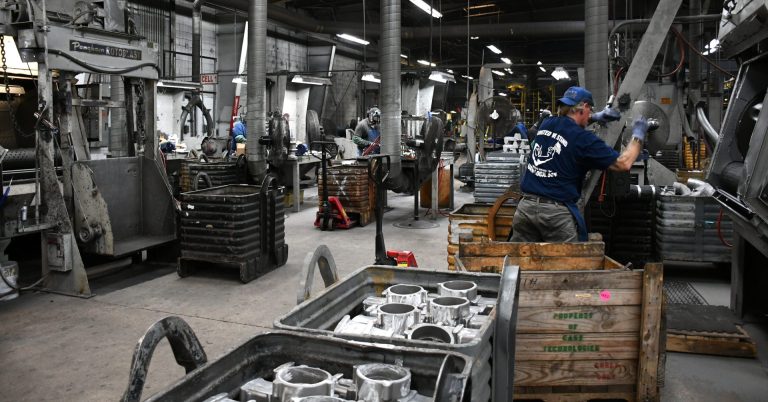Checking out the Craft: All About Aluminum Casting Techniques
Checking out the Craft: All About Aluminum Casting Techniques
Blog Article
Crafting Perfection: Exactly How to Achieve High-Quality Light Weight Aluminum Castings Whenever
In the realm of aluminum casting, the search of excellence is a continuous journey that calls for a careful method and an eager understanding of the ins and outs entailed. Accomplishing consistent premium light weight aluminum castings requires a thorough understanding of the processes, from picking the appropriate alloy to performing precise mold layouts and thoroughly managing casting parameters.
Understanding Light Weight Aluminum Spreading Processes
Aluminum casting procedures, essential in the production sector, include the complex makeover of molten light weight aluminum into strong forms with a collection of very carefully regulated steps. Recognizing these processes is vital to accomplishing premium aluminum spreadings consistently - about aluminum casting. The main methods made use of in light weight aluminum casting are die casting, sand spreading, and investment casting

Each of these procedures has its benefits and is chosen based upon aspects like intricacy, volume, and desired coating of the light weight aluminum spreading. about aluminum casting. Understanding the complexities of these techniques is important for manufacturers aiming to create top quality light weight aluminum castings continually
Choosing the Right Light Weight Aluminum Alloy
Picking the ideal aluminum alloy is a crucial decision in the production of high-grade aluminum spreadings. When picking an aluminum alloy for casting, it is essential to consider the particular needs of the application to guarantee optimum efficiency.
Among one of the most frequently utilized light weight aluminum alloys for spreading is A356. This alloy provides outstanding castability, high stamina, and good rust resistance, making it appropriate for a wide variety of applications. Alternatively, 6061 light weight aluminum alloy is preferred for its exceptional weldability and excellent mechanical buildings. For applications needing high stamina, 7075 aluminum alloy is a popular option as a result of its exceptional strength-to-weight proportion.
Along with mechanical residential or commercial properties, factors to consider such as cost, schedule, and post-casting procedures need to likewise affect the choice of the right aluminum alloy. By very carefully examining these variables, suppliers can ensure the production of high-quality aluminum castings that satisfy the preferred specs.
Implementing Proper Mold Design
Creating an effective mold layout is critical for making certain the successful production of top notch aluminum castings. Proper mold and mildew design plays a significant role in achieving the preferred qualities of the end product. To additional info implement a successful mold and mildew style, factors such as product circulation, cooling down prices, and part geometry need to be thoroughly considered.
One secret facet of mold and mildew style is ensuring correct dental filling and solidification of the light weight aluminum within the mold tooth cavity. This includes designing jogger and gating systems that help with smooth metal circulation and stop issues such as air entrapment or insufficient dental filling. Furthermore, incorporating cooling networks right into the mold and useful site mildew style helps manage solidification prices and reduce the risk of porosity or shrinking problems.

Controlling Casting Parameters

Making Certain Post-Casting Top Quality Checks
To keep the high quality of aluminum castings, complete post-casting high quality checks are necessary. After the spreading process is finished, it is crucial to make certain that the last products fulfill the preferred requirements and requirements.
Dimensional precision is one more crucial aspect that needs to be confirmed throughout post-casting high quality Click Here checks. Dimensions of crucial dimensions and tolerances must be taken to verify that the spreadings comply with the required specs. Furthermore, mechanical residential properties such as hardness, tensile toughness, and effect resistance may require to be examined with product testing to make certain that the castings possess the necessary stamina and resilience for their desired application.
Conclusion
Finally, accomplishing top quality light weight aluminum spreadings requires a comprehensive understanding of the casting procedures, picking the ideal alloy, designing mold and mildews properly, managing casting parameters thoroughly, and performing post-casting high quality checks carefully. By complying with these steps, suppliers can continually create aluminum spreadings that satisfy the highest criteria of high quality and performance.
Attaining constant high-grade light weight aluminum spreadings demands a comprehensive grasp of the processes, from choosing the suitable alloy to carrying out accurate mold styles and carefully managing casting specifications. The primary techniques made use of in light weight aluminum casting are die spreading, sand spreading, and investment spreading.
Financial investment spreading, additionally recognized as accuracy spreading, involves developing wax patterns that are coated in ceramic to create molds.Selecting the ideal aluminum alloy is an important decision in the manufacturing of high-quality aluminum spreadings.Ensuring precise control over casting specifications is vital for keeping consistency and high quality in light weight aluminum casting manufacturing.
Report this page